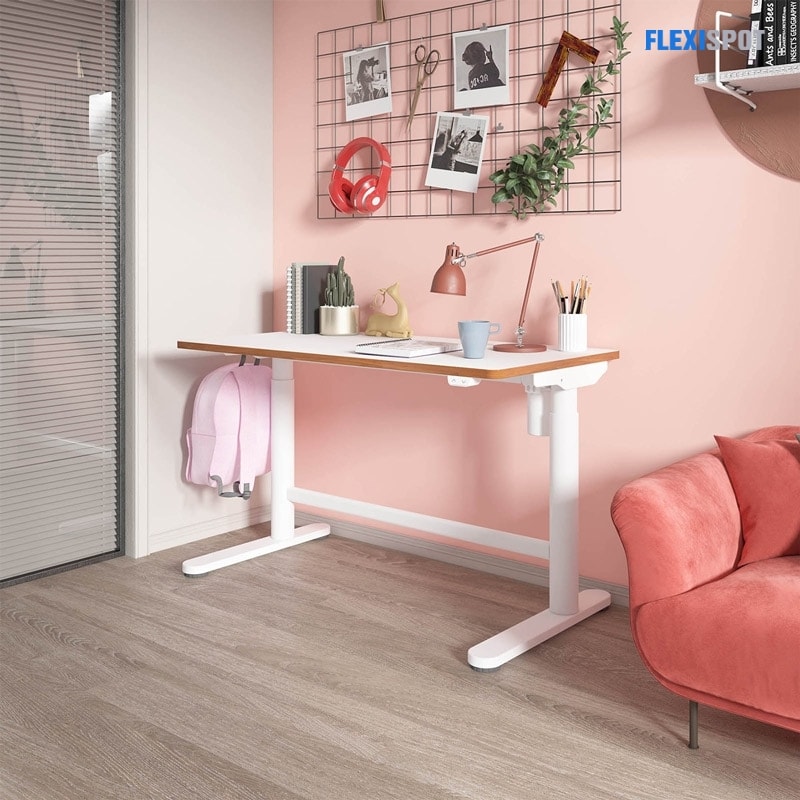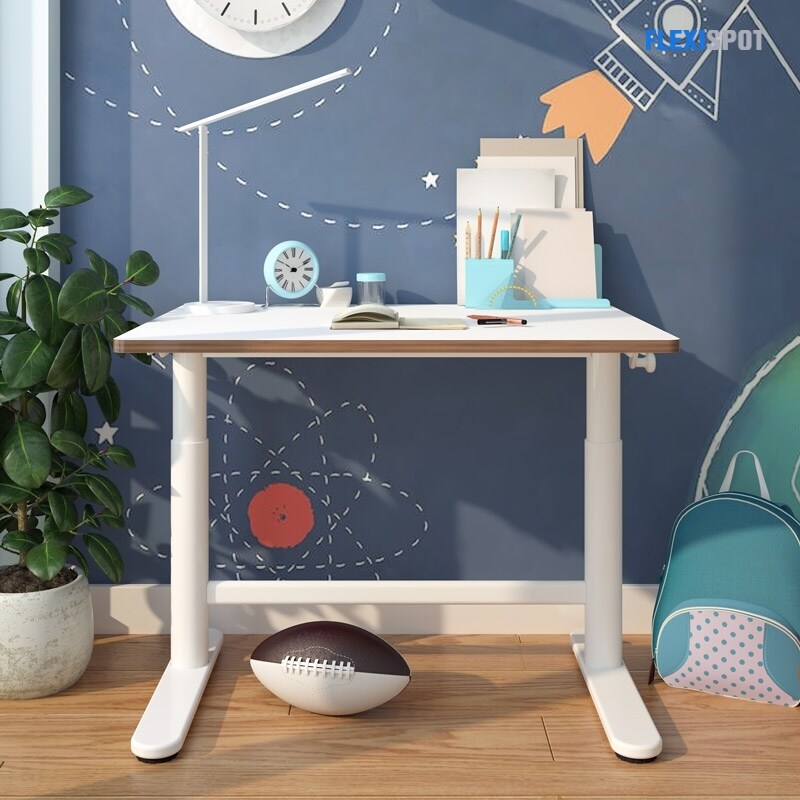With the new school year beginning in the midst of a coronavirus pandemic, many kids will be heading back to pure distance education or a hybrid approach, with at least some of their education taking place in the home. This presents many fresh challenges for families, such as building a decent ergonomic setup for extended hours of homework at home. A flexible learning setup that is ergonomically correct is essential because it helps prevent long-term posture problems and pain.
Children's ergonomic principles guidelines are typically similar to those of adults. The only difference is that they must find the appropriate equipment for their smaller size while also accommodating them as they grow throughout the school year. Encouraging healthy habits and correct sitting ergonomics for children finishing virtual classwork will aid in the prevention of discomfort and postural issues in the future. Because their bones have not yet merged, children are especially vulnerable to alterations in spinal alignment, dramatically increasing their risk of back problems such as kyphosis and scoliosis over time.

If your child is one of the millions who went back to school last fall, you've most likely already set up a workstation for them. If you haven't yet for the coming school year, look into getting them a sit-stand desk so they can conveniently get up and move around when needed. Since we all know, children, particularly the very young and fidgety, almost spontaneously enjoy being able to stretch out and shake off their hands and feet from time to time through physical movements and activities. Standing desks alleviate this anxiety by permitting them to expend energy in transitioning from sitting to standing and conversely. FlexiSpot offers us Height Adjustable Ergonomic Study Desk/Kids Desk that comes in a height range of 21.7" to 35" and is perfect for the young ones, and the Height Adjustable Ergonomic Study Desk with a height range of 29" to 48.6" and is ideal for growing kids and teenagers.
Did you also know that, even if you do not have a stand-up desk, by making a few minor tweaks, you can transform that standard workspace into a comfy, ergonomically sound environment that will assist them in concentrating, being productive, and avoiding discomfort? We've put together a list of virtual learning ergonomics recommendations to help you with this project.
Assign a Learning Space
It is critical to have separate areas for different activities such as sleeping, eating, and learning. Establish a "quiet spot" where your child can go to unwind or decompress if they become swamped.
Stick To A Routine
Maintaining a consistent morning routine of getting ready, brushing teeth, eating breakfast, and going to their study space will make children feel more structured and prepared to face the day.
The Desk and Chair Setup
It's not good to sit all day. Anything static is undesirable, so if you can obtain an ergonomic sit-stand desk, that is ideal. However, if you have a table or desk nearby, you can undoubtedly improvise a lot of the solutions you'll need. However, the chair is crucial. If your budget allows you to buy only a chair or a desk, buy the chair and choose one that will enable you to adjust the seatback, seat angle, height, and armrests.
- Elbows must be bent to about 90 degrees, with forearms resting on the desk.
- Wrists on the mouse, keyboard, or desk should be neutral (not bent).
- When typing, the desk should be completely flat.
- If they are typing for longer, a raised display with an external keyboard will allow better positioning and prohibit shoulder and neck tension. Place the laptop on a thick binder to lower the keyboard and elevate the screen. You can also expand the laptop to tilt the keyboard down for better access.
- Small hands may require a smaller mouse and a keyboard.
- Hips should be supported at a 90-100-degree angle, with the back of the knees toward the front edge of the chair and then both feet flat on the ground. They should also be able to sit back in the seat, back supported, with their knees at a 90-degree angle.
- The chair does not need to constrain their legs; instead, it can permit some moves, which helps to stimulate their core muscles and promotes active sitting.
- A chair that can be adjusted and elevated as they grow is a great option.
- The chair can be boosted to a suitable height for their desk, and a box can be placed beneath their feet to provide support if their feet are hanging.
- The backrest should come up to their shoulder blades and provide enough support through the lower back to encourage an upright sitting position. Add a pillow behind them if they can't rest their back in the chair while bending.
Plan Regular Breaks
The chance to move will help your kids relax and focus during class. Find out when your child's breaks are throughout the day and make the most of them by engaging in energizing activities such as going for strolls around the community or practicing yoga.
Adequate Lighting
Prevent eye strain by providing adequate lighting that does not necessarily require more screen brightness. It is best to use a desk lamp with a dimmable lightbulb that can be modified throughout the day. To reduce glare from the sun, place your child's screen at a 90-degree angle to any windows. Blue light from electronic devices has been shown to repress your body from producing melatonin, which affects your sleep pattern. Blue light can be mitigated by receiving at least 30 minutes of daylight exposure. You can also encourage healthy sleep by trying to limit screen time use a few hours before going to bed and attempting to remove digital devices from the bedroom.
Hydration and Nutrition
Providing water nearby will help your kids stay focused by preventing them from having to get up when they are thirsty. Crunchy foods such as carrots, pears, apples, and pretzel sticks stimulate and keep children entertained. Sour foods and mints are also delicious.
Allow Movements
On the other hand, movement is one of the most noticeable things lacking in a virtual classroom. So, even if you've perfected your ergonomics, don't force your children to move every 30 minutes. Allow your child to stand at a standing desk or countertop or lie on the ground or bed with their elbows propped up for a few minutes. You could even tape some paper to the window or wall to practice handwriting. Therapy/yoga balls are also an acceptable option for chairs because they allow children to move and hop around during class, helping to keep them alert and releasing extra energy.
Backpacks
When it comes to selecting a suitable backpack for children who are going back to in-class education, there are a few things to keep in mind:
- The backpack should not be larger than the child's torso width and length. To distribute weight, select cushioned shoulder straps and, if possible, a hip buckle.
- Fill up the backpack with the heaviest items at the base and against their back, and the lightest items at the front.
- Backpacks should not weigh more than 15% of the child's body weight.
- Adjust the shoulder and hip straps so that the bag rests higher on their back and snugly toward their back.
Effects of a Poor Ergonomic Setup
- If poor posture is not fixed from an early age, it can lead to long-term neck and back issues.
- Possible side effects of a poor configuration include the forward head and weak back muscles.
- Poor concentration or involvement, becoming easily distracted, headaches, or muscle aches are all possible side effects.
An ergonomic workplace minimizes discomfort and the risk of injury. With the rise of virtual learning, having an ergonomic workspace has never been more critical – not just for adults anymore, but also for children.

